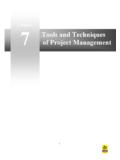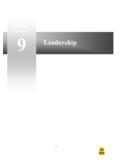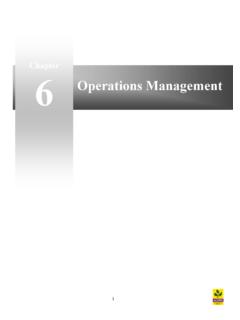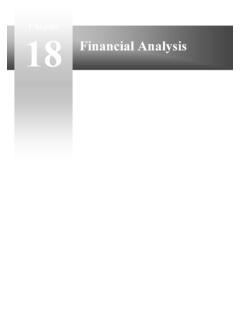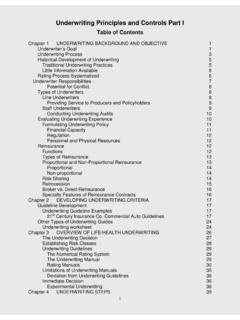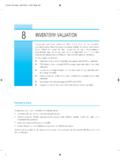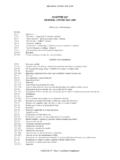Transcription of P1 Performance Operations Revision Summaries
1 1 P1 Revision Summaries CIMA Operational Level Paper P1 Performance Operations ( Revision Summaries ) Chapter Topic Page Number 1 Classification of costs and mathematics for budgets 3 2 Advanced mathematics for budgets 7 3 Absorption, marginal and activity based costing 13 4 Standard costing and variance analysis 19 5 Modern manufacturing methods 29 6 Environmental cost accounting 33 7 Mathematical techniques for decision-making 37 8 Investment appraisal 39 9 Asset replacement theory 43 10 Working capital 45 11 Managing inventories 49 12 Managing trade receivables and payables 55 13 Cash flow forecasts and managing cash 61 14 Short term borrowing and investing 65 15 The normal distribution 71 2 P1 Revision Summaries 3 P1 Revision Summaries Classification of costs and mathematics for budgets Chapter 1 4 P1 Revision Summaries Financial Accounting (External information) Financial accounts are produced mainly for external users shareholders or investors.
2 Management Accounting (Internal information) Management accounts are produced for internal users of financial information within an organisation directors and management. Types and classification of costs A direct cost or variable cost is a cost that can be easily identified or related to a cost per unit or activity level. Cost ( ) Direct or variable cost Output or activity level (units) 5 P1 Revision Summaries Indirect overhead or fixed cost is a cost which cannot be easily identified or related to a cost per unit or activity level. Examples include a factory supervisor s salary or factory rent and rates. Semi-variable cost is a cost containing both fixed and variable components and thus partly affected by a change in the level of activity.
3 Stepped fixed costs are fixed costs that remain constant but only within a certain range of production. Once this range of production is exceeded the fixed cost will rise. Cost ( ) Indirect overhead or fixed cost Output or activity level (units) Example - Semi-variable cost Example - Stepped fixed cost Cost Cost ( ) ( ) Activity level Activity level 6 P1 Revision Summaries Forecasting techniques Forecasting methods budget, forecast or project by extending historical data into the future, the various techniques include. High-low technique The line of best fit using human judgement Regression analysis (or least squares method ) Time series The linear relationship for sales or cost forecasting, normally expressed as Y= a + bX High-low technique The high-low technique uses the highest and lowest level of activity given and the associated costs, to separately identify the variable and fixed cost components.
4 The line of best fit using human judgement A scatter-graph is a graphical method of creating a forecasting model by using the line of best fit drawn free hand that closely matches or approximates to a series of data that has been plotted on the graph. Production expenses Direct material the direct raw material Direct labour the labour physically engaged in making the product such as factory staff wages. Variable production overhead direct factory expenses other than material or labour such as hiring production equipment. Prime cost = total direct material + total direct labour + total variable production overhead Fixed production overhead production overhead incurred not easily attributed or ascertained to a cost object or cost unit factory supervisor salaries. Non-production overhead Those costs which are not directly relate to the making of the product but support this process.
5 For example administration overhead, selling overhead and distribution overhead. A period cost is a cost deducted as an expense during an accounting period; it is a cost relating to time rather than the manufacturing or brought in cost of a product. A product cost is the cost of making a finished product or the cost of purchasing a product for resale. 7 P1 Revision Summaries Advanced mathematics for budgets Chapter 2 8 P1 Revision Summaries Regression analysis (or method of least squares ) uses a formulae (provided in the exam) in order to calculate a more scientific line of best fit . It is therefore harder to understand, however far more accurate. It creates a model (Y = a + bX) that can be used as a forecasting technique. Formulae provided in your exam Y = a + bX b = n XY ( X)( Y) n X2 ( X)2 a = Y bX Correlation coefficient measures the strength of the relationship between X and Y, always giving a value between the range between -1 and +1, indicating how perfect your relationship is between X and Y and also whether the relationship is a positive or negative one.
6 Correlation coefficient (r) = n XY ( X)( Y) ((n X2 ( X)2)( n Y2 ( Y)2)) Coefficient of determination measures how much a particular variable is determined or explained by another. To calculate this you simply square the correlation coefficient therefore obtaining r2. It will provide you with a percentage and the higher the percentage the more determined or explained a variable is by another. Time series A time series is historical values recorded over time, such as total cost against output or monthly sales against time. Two models for forecasting Additive model TS = T + (+/-) SV Multiplicative model TS = T x SV (as a decimal or index value) Trend (T) or Y = a + bX 9 P1 Revision Summaries A limiting factor or principle budget factor means you do not have enough of a resource in order to produce or sell all you would like.
7 Method for limiting factor analysis Identify the limiting factor Contribution per unit Limiting factor used in each product Contribution per unit of limiting factor Rank Contribution per unit = Sales price per unit less all variable cost per unit (it ignores all fixed cost). Contribution earned per unit of scarce resource = Contribution per unit Number of units of scarce resource required in order to produce it Break even analysis or cost volume profit (CVP) analysis Cost-volume-profit (CVP) analysis looks at how profit changes when there are changes in variable costs, sales price, fixed costs and quantity. 10 P1 Revision Summaries Formulae to learn Contribution per unit = Sales price per unit less variable cost per unit Break-even volume = Fixed overhead Contribution per unit sold Contribution to Sales ratio (C/S ratio) = Contribution per unit Sales price per unit or = Total contribution from a product sold Total sales revenue earned from a product sold Break-even revenue = Fixed overhead C/S ratio or = Break-even volume x Sales price per unit sold Margin of safety (units) = Budgeted sales volume less Break-even sales volume Margin of safety (%)
8 = Budgeted sales volume less Break-even sales volume x 100 Budgeted sales Number of units sold to achieve a target profit = Fixed cost + Desired profit Contribution per unit 11 P1 Revision Summaries Break-even charts O u t p u t ( u n i t s )M a r g i no fs a f e t yB u d g e t e do r a c t u a ls a l e sB r e a k -e v e np o i n tS a l e sr e v e n u eT o t a lc o s t sV a r i a b l e c o s t sF i x e d c o s t sC o s t a n dr e v e n u e 0 Profit volume charts: Loss = fixedcosts at zerosales activityBreak-evenpointSalesLoss Profit0 What if analysis, spreadsheets and databases used in budget preparation What if analysis looks at varying or changing the key variables to see how the outcome would change. These changes would be due to the Revision of expectations on the value of variables such as material costs or demand. Spreadsheets are a useful tool to build models for management information and aid the preparation of budgets.
9 A database organises the collection of data or information stored on a computer. A database management system (DBMS) manages and provides access between the different application programmes and information stored in the database. 12 P1 Revision Summaries 13 P1 Revision Summaries Absorption, marginal and activity based costing Chapter 3 14 P1 Revision Summaries Absorption costing Traditional absorption costing takes the total budgeted fixed overhead for a period and divides by a budgeted (or normal) activity level in order to find the overhead absorption rate. This is a simple fixed overhead costing method, allowing fixed overhead to be allocated to products, jobs, and stock or work-in-progress. Overhead absorption rate (OAR) = Budgeted production overhead Normal level of activity Any under charge to the profit and loss account would be an under absorption of production overhead DR profit and loss account CR Production overhead control account.
10 Any over charge to the profit and loss account would be an over absorption of production overhead CR profit and loss account DR Production overhead control account. Marginal costing A marginal cost (direct or variable cost) is a cost that can be avoided if a unit is not produced or incurred if a unit was produced. Fixed cost remains constant whether a unit is or is not produced. Marginal (or variable) costing assigns only variable costs to cost units while fixed costs are written off as period costs. Cost per unit: Direct costs of production Direct labour X Direct material X Direct variable production overhead X Total direct variable cost or total prime cost X Marginal costing stock valuation Indirect production overhead absorbed X Full production cost X Absorption costing stock valuation 15 P1 Revision Summaries Marginal costing pro forma income (profit) statement Sales X Less cost of sales Opening stock (valued at variable production cost only) X Total variable production cost* X X Less closing stock (valued at variable production cost only) (X) (X)



